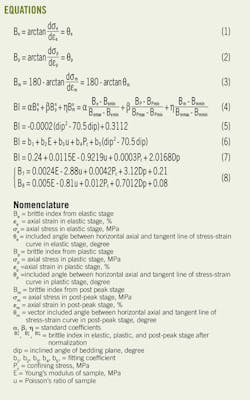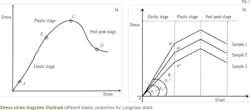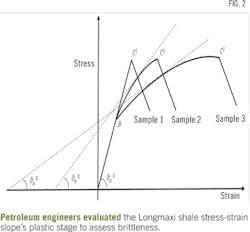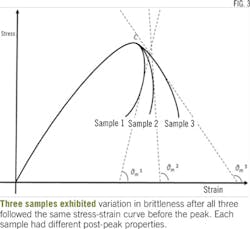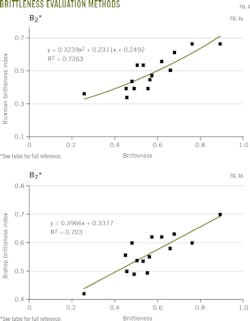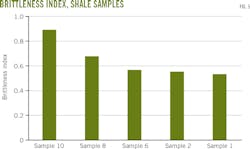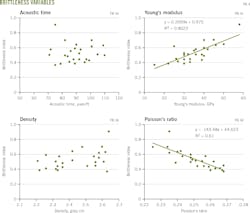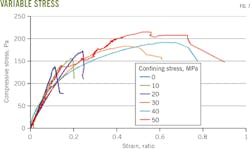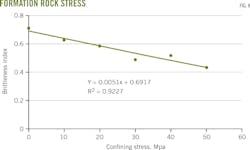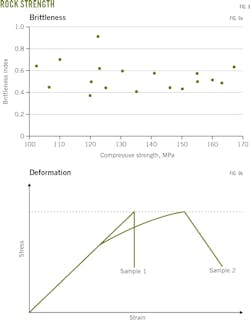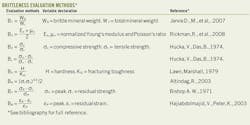Index measures brittleness in China's Longmaxi shale
Xiangjun Liu
Yi Ding
Luoping Ya
Southwest Petroleum University
Chengdu, China
Acoustic time and density have a poor relation with brittleness while elasticity has a good linear correlation with brittleness. Variable compressive strength causes irregular brittleness distribution, meaning rock strength cannot indicate brittleness. Shale having high confining stress, however, exhibited relatively low brittleness, suggesting that confining stress is crucial to brittleness evaluation. Brittleness increases at first with increasing inclination but then drops, reaching its maximum value at 45°.
High brittleness is a prerequisite for petroleum engineers looking for hydraulic fracturing targets in shale plays. The oil and gas industry lacks a scientific definition for brittleness even though more than 20 evaluation methods have been proposed.
No consensus exists on which method is most reliable. This article presents an index to help quantify shale brittleness. A stress-strain curve from a triaxial test divided brittleness characteristics into three stages: elastic, plastic, and post-peak.
Rock mechanics suggest distinct behavior at each stage. The authors established equations for each stage as part of the brittleness index. They used three types of slopes in a stress-strain curve.
Laboratory testing used core samples taken from Longmaxi natural gas shale in southern China. Initial shale exploration and development efforts in China have focused on this Sichuan basin formation (OGJ, July 6, 2015, p. 40).
The brittleness index outlines four shale brittleness factors: physical properties, confining stress, rock strength, and formation structure. The authors proposed a shale brittleness forecasting model using multiple linear regressions.
Uncertainties inevitably cause errors in quantifying brittleness. Most methods evaluate brittleness during the loading process instead of considering brittleness throughout the fracturing process, impairing precise evaluation.
Brittleness evaluation methods
Rock mechanics do not offer a universal brittleness measurement. The accompanying table shows the equations behind some of the most widely-used brittleness evaluations. Industry typically uses the methods that this article calls B1 and B2
Method B1 suggests high mineral content represents strong brittleness. But a limitation exists because mineral content does not consider external influences.
Method B2 uses Young's modulus and Poisson's ratio to assess shale brittleness. It suggests shale with high Young's modulus and a low Poisson's ratio has high brittleness. B2 is based on statistical results.
Fracture mechanics characterize brittle material as being highly resistant to deformation with only slight resistance to fracturing. This principle establishes strength parameters in Methods B3-B6.
Strength parameters can indicate brittleness but are vulnerable to error by focusing on the peak point at loading, neglecting brittleness before and after the peak.
Some scholars have concluded rock with high brittleness has rapid strength reduction after shear failure. B7 applies peak strength or strain to assess brittleness while B8 applies residual strength or strain to assess brittleness. Post-peak parameters are incapable of expressing brittleness in pre-peak areas.
Additional brittleness evaluation for shale formations is needed. Rock properties can vary widely in shale plays.
Stress-strain curve
The stress-strain curve demonstrates brittleness characteristics separated into three parts: elastic stage (A to B), plastic stage (B to C), and post-peak stage (C to D), as shown in Fig. 1a.
Each stage has distinct brittleness properties, enabling a brittleness evaluation equation. Brittleness during the elastic stage can be measured from the stress-strain curve's elasticity.
Rock tends to strongly resist deformation before shear failure, requiring the application of more stress. Fig. 1b shows stress-strain diagrams of different elasticity for three shale samples. The plastic-stage curve's slope can be used to evaluate brittleness.
Sample 1's curve went straight to peak point without any sign of plastic performance, indicating strong brittleness. Sample 3's curve deviated after running straight in the elastic stage, showing strong plasticity and ductility. Sample 3 had the lower brittleness. A rising slope in the elastic stage was used to measure brittleness (Equation 1).
Figs. 1-3 show refers to the angle between the horizontal axial and tangent line of the stress-strain curve in the plastic stage.
The stress-strain curve normally is simplified to two phases: before-peak stage and after-peak stage. The before-peak stage is the elastic stage. The stress-strain curve shows a transition from the elastic stage to the plastic stage.
Brittle behavior is characterized by reversible deformation before shear failure. Differences exist in the plastic stage where rock can be deformed under steady or increased load.
Large irreversible deformation represents a strong ability to endure stress and high plasticity. Equation 2 outlines evaluation methods for the plastic stage.
Both the elastic and plastic stages belong to the pre-peak region. Numerous studies prove shear failure is directly associated with brittleness. Fig. 2 shows how three samples vary in brittleness yet had the same stress-strain curve shape before peak. The lack of ability to detect variation when assessing only before-peak stage prompted use of the post-peak curve slope to measure brittleness (Equation 3).
The index considered brittleness in the elastic, plastic, and post-peak stages. Equation 4 involves standard coefficients used to calculate factors influencing each stage.
Fig. 3 shows rock having the same elastic and post-peak properties but different stress curves in the plastic stage.
The brittleness index was verified by comparing it with existing brittleness evaluation methods. Figs. 4a-4b show clear correlations between the index and other evaluation methods, demonstrating the index's applicability.
Fig. 5 shows the brittleness index for 5 of 30 core samples studied. The brittleness index accurately forecast fracturing as demonstrated by core samples.
Sample 10 and Sample 8 had high brittleness index values and those cores exhibited multiple cracks. Sample 2 and Sample 1 had small index values and those cores showed few cracks.
Physical properties affected brittleness (Figs. 6a-6d). Brittleness, however, was not directly correlated with either density or acoustic time. Young's modulus and Poisson's ratio had clear correlations with brittleness. Brittleness increased with increased Young's modulus and decreased Poisson's ratio.
Fig. 7 shows how forecasting brittleness must consider confining stress. The triaxial test used confining stress to simulate the formation rock's state. Increased axial stress triggered shear failure, revealing the shale's mechanical rock properties to calculate stress-strain curves.
Different confining-stress situations expanded understanding of Longmaxi shale brittleness. Rock exhibits variable stress states at different depths. Confining stress provides lateral bracing for shale. Shale's strain and strength properties change under different confining stress situations. Fig. 8 shows brittleness declining with increased confining stress.
Fig. 9a shows scattered brittleness distribution with varying compressive strength. Rock deformation significantly affects brittleness, but rock strength has no direct connection with rock deformation.
Fig. 9b shows two samples having the same strength but different deformation. Sample 2 had stronger ductility in the stress-strain curve, meaning less brittleness. Sample 1 exhibited high brittleness.
Bedding plane angle
The typical structure of shale is bedding plane. Core samples with different inclinations allowed determination of how Longmaxi shale's bedding plane angle affects brittleness.
Equation 5 shows a correlation between inclined angle and brittleness, demonstrating that an increasing inclined angle initially leads to increased brittleness, reaching maximum value at 45° before dropping. Brittleness rose at intermediate inclination angles because of shale's failure mode, which coincided with bedding plane angle.
The bedding plane was weak, enabling slipping that contributed to high brittleness.
Equation 6 shows multiple linear regression parameters to forecast brittleness. A least-square calculation was used to acquire an optimal coefficient (Equation 7).
Wei 204-HS well statistics showed a bedding plane with an inclined angle of 24° at 2,200-2,385 m. Mineral composition indicated high brittleness at 2,260-2,310 m.
Field data confirmed that this section provided effective fracturing opportunity. The brittleness forecast shown in Equation 8 was consistent with field data, showing the forecast model's practicality. The index, however, showed scattered brittleness properties in this middle section, making it difficult to plan fracturing targets despite its good fracturing network. Even so, precise evaluation in a laboratory provided the necessary base to accurately guide fracturing.
Acknowledgment
The authors acknowledge support from the National Natural Science Foundation of China (U1262209), the Ministry of Science and Technology of China (2011ZX05020-007-06), and the Application Basic Research Project of Sichuan Province (2014JY0092).
Bibliography
Bowker, K. A., "Barnett Shale gas production, Fort Worth Basin: Issues and discussion," American Association of Petroleum Geologists Bulletin, Vol. 91, No. 4, April 2007, pp. 523-533.
Morley, A., "Strength of Materials," London: Longman Green, 1944, pp. 71-72.
Qinghui, L., Mian, C., and Yan, J., "Indoor evaluation method for shale brittleness and improvement," Chinese Journal of Rock Mechanics and Engineering, Vol. 31, No. 8, August 2012, pp. 1680-1685.
Yun, C., Yan, J., and Mian, C., "A rock brittleness evaluation method based on energy dissipation," Chinese Journal of Theoretical and Applied Mechanics, Vol. 47, No. 6, pp. 984-993, June 2015.
Jarvie, D. M., Hill, R. J., Ruble, T. E., and Pollastro, R.M., "Unconventional shale-gas systems: The Mississippian Barnett Shale of north-central Texas as one model for thermogenic shale-gas assessment," AAPG Bulletin Vol. 91, No. 4, April 2007, pp. 475-499.
Rickman, R., Mullen, M. J., Petre, J. E., Grieser, W.V., and Kundert, D. K., "A Practical Use of Shale Petrophysics for Stimulation Design Optimization: All Shale Plays Are Not Clones of the Barnett Shale," Society of Petroleum Engineers Technical Conference and Exhibition, Denver, Sept. 21-24, 2008.
Hucka, V., and Das, B., "Brittleness determination of rocks by different methods," International Journal of Rock Mechanics & Mining Science & Geomechanics, Vol. 11, No. 10, Oct. 1974, pp. 389-392.
Lawn, B.R., and Marshall, D. B., "Hardness, Toughness, and Brittleness: An Indentation Analysis," Journal of the American Ceramic Society, Vol.62, Nos. 7-8, July-August 1979, pp. 347-350.
Altindag, R., "Correlation of specific energy with rock brittleness concepts on rock cutting," South African Institute of Mining and Metallurgy Journal, Vol. 103, No. 3, March 2003, pp. 163-171.
Bishop, A.W., "The Influence of Progressive Failure on the Choice of the Method of Stability Analysis," Geotechnique, Vol. 21, No. 2, June 1971, pp. 168-172.
Hajiabdolmajid V., and Kaiser P., "Brittleness of rock and stability assessment in hard rock tunneling," Tunnelling & Underground Space Technology, Vol. 18, No. 1, February 2003, pp. 35-48.
Zhou, H., Meng, F., Zhang, C., Xu, R.C., and Lu, J.J., "Quantitative evaluation of rock brittleness based on stress-strain curve," Chinese Journal of Rock Mechanics & Engineering, Vol. 33, June 2014, pp. 1114-1122.
Park, J. A., Park, B., and Min, K. B., "Comparisons of Brittleness Indices of Shale and Correlation Analysis for the Application of Hydraulic Fracturing," Journal of Korean Society for Rock Mechanics, Vol. 24, No. 4, April 2014, pp. 325-333.
The Authors